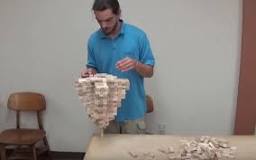
Surely you’ve played Jenga. You know, the one with stacked blocks – you have to pull one block out from the middle and stack it on top, and the person who causes the stack to fall loses the game.
It’s such a simple game. It’s just a set of 54 wooden blocks.
Dig a little deeper, though. There’s so much symbolism and so many parallels to life in the game.
Tipping the Balance in Your Favor
You take a very close look at the stack before placing your cleanly extracted block on the top. You notice that, on two adjoining levels, there is only a singular, center block. Yet, you’ve observed that the stack is still showing signs of stability. Since there are 6 people playing, and the goal is for someone else to lose, you realize you can destabilize the stack enough on your turn that it won’t last long. You set your block off-center. Lo and behold, two players beyond you, the stack comes tumbling down.
While in the game of life, we’re (hopefully) in the practice of building people up (see the next analogy), there are still plenty of times where it’s a good idea to create your own advantage. Look at Elon Musk. He’s currently disrupting four different industries, all at once. His electric car business, Tesla, tipped the balance in its favor by gaining tax credit status for car purchases, promoting the lower total cost of ownership of electric cars, and leveraging the rise of environmental consciousness in our society. Pretty soon, you’ll start to see the dominance of the internal combustion engine come tumbling down…
Creating Stability Through Careful Planning
Another approach to the game is to work together to see how high the stack can go. In Jenga, the 54 blocks are arranged in 3-across platforms placed perpendicular to each other. This gives you a starting height of 18 platforms.
If all the players decide to work together, and remove and place blocks where the best balance can be retained, it’s possible to more than double the starting height. The official record turns out to be 40 complete levels with two blocks on the 41st. It may take an engineering degree to get to this point, but carefully planning the moves will certainly make your stack grow taller than haphazard placement.
Similarly, by stepping back and carefully planning your moves in life to build a solid foundation, you can achieve far greater heights than by simply doing whatever seems convenient at the time. Sure, with greater risks, the tower may fall and you may have to start over, but the satisfaction of your soaring accomplishments will give you encouragement to keep on trying!
Finding Opportunity Through Gentle Experimentation
One useful technique to playing Jenga is the “Tap”. You gently tap random blocks in the stack to find loose ones, easily pulling one of the loose ones out without toppling the tower.
In much the same way, people and companies will try out new ideas and different possibilities to determine which will work best. When experimenting, though, the “gentleness” is the important part – it’s important to do so in a way that won’t disrupt everything else. You find a safe space, or a low-cost method, or some other means of controlling your experiment to keep it from causing too much damage to everything else.
The Main Lesson
The lesson here is simple: When grappling for answers to any question, always think of the Jenga tower. It’ll give you the clues you need. And it’s not just “life lessons”, it’s everything:
- Physics? Gravity.
- Oceanography? The tipping point when an invasive species kills the ecosystem.
- Religion? The Tower of Babel.
- Music? The pitch of the sound created when a Jenga block falls is right around 1000 Hz.
- Baking? The cutouts of the top crust of a pie call to mind a Jenga tower with blocks removed.
Need I say more?

Eric Keller says:
Love it!